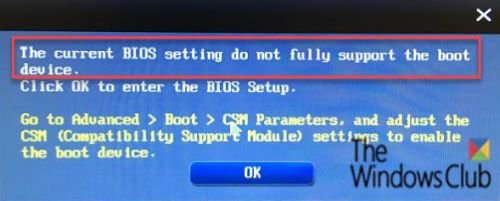The current BIOS setting do not fully support the boot device
If you’re experiencing this issue, we suggest you try these solutions in no particular order: Now, let’s take a detailed look at the listed troubleshooting.
1] Check your HDD physically
This solution requires you to open the computer and disconnect and reconnect the hardware inside. Proceed only if you know what you are doing or take the computer to a hardware technician to perform the procedure. If this is a new or relatively new build, check the HDD for connection issues. Open the computer and disconnect the SATA cable from the HDD and motherboard. Also, disconnect all the power from the HDD and leave the components idle for a few minutes. Now plug all the cables and connect the hard drive to your motherboard. Boot the computer and see if the issue is resolved. If that does not work, try plugin the HDD to a different SATA port on the MOBO to see if that helps.
2] Perform Startup Repair
Windows 10 Startup Repair is an alternate way to boot the PC and run recovery tools when something goes wrong with the operating system. Do the following:
Insert the Windows 10 installation DVD/USB and restart your computer.After you boot your computer using Windows DVD/USB or System Repair Disc, a black screen appears with gray text “Press any key to boot from CD or DVD”. Press any key.Select the correct time and Keyboard type.Click Repair your computer in the lower-left corner.Select Troubleshoot from Choose an option screen.Click Advanced options in Troubleshoot screen.Click Automatic/Startup Repair.
Windows will then look for problems on the hard drive(s) and verify that all required files are intact.
3] Check boot device priority
Start the computer and press ESC/F1/F2/F8 or F10 during the initial startup screen to enter the BIOS Setup screenChoose Enter BIOS setup option.Since the mouse does not work, use the arrow keys to navigate.Go to the Boot tab.Now check the boot device order. Make sure your HDD is selected as the priority device.Exit and restart the computer.
Check if the error is resolved. If not, proceed with the next solution.
4] Reset BIOS settings
To reset the BIOS settings, do the following:
Restart your computer and repeatedly press ESC/F1/F2/F8 or F10 during the startup to get into BIOS.If you are using Windows 10, click on Start and select Power.Now press and hold the Shift key and press Restart.Go to Troubleshoot > Advanced Options > UEFI Firmware Settings and click on Restart.Once you are in BIOS, press F9 to open the Load Default Options dialogue box.Select Yes using the arrow keys to reset BIOS settings to factory default.Exit and restart the computer.
On boot, check to see if the BIOS error is resolved. That’s all there’s to successfully resolving the issue.

